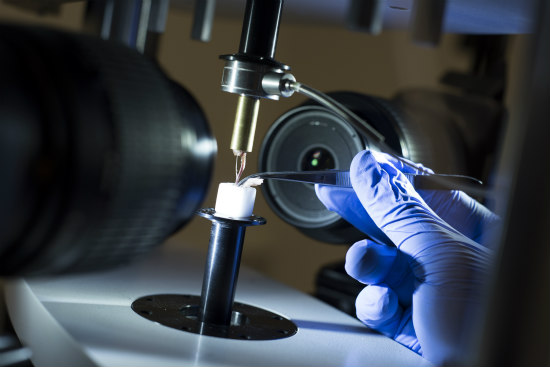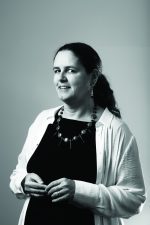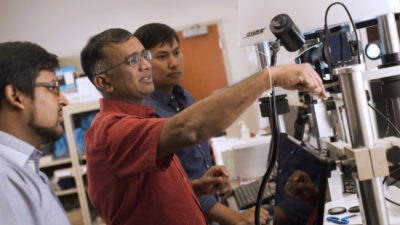UMKC researchers are trying to alleviate the decline of bone and muscle as we age
As a faculty advisor to the UMKC School of Computing and Engineering’s Big Beam team, Ganesh Thiagarajan, Ph.D., helps students design and build load-bearing structures for bridges. Using bridgemaking technology and mouse bones — yes, you read that right — Thiagarajan is working to find better ways to support humans as they age, giving them longer, healthier lives.
Thiagarajan has partnered with researchers Mark Johnson, Ph.D., and Sarah Dallas, Ph.D., at the UMKC School of Dentistry, on a multiyear, $1 million-plus research project to examine the effects of aging on bone and muscle. Declines in bone and muscle that occur with normal aging can result in osteoporosis (bone deterioration) and sarcopenia (muscle loss).
The team has hypothesized that bone produces factors that support muscle function, and muscle produces factors that condition bone’s response to loading. And aging affects this crosstalk, leading to the decline observed in these tissues. Thiagarajan’s research focuses on mechanical signaling in bone.

Simulating mechanical stress, or load, on mouse bones provides a glimpse into regeneration.
Now in their final year of National Institutes of Health funding, the team is exploring how bone cells respond to mechanical loading, and how gender and age impact growth of the skeleton and its mechanical responsiveness. Specifically, they are looking at loading in mouse bones to determine how specialized cells embedded in the bone — called osteocytes — sense the load input and how the body responds by preparing for new bone to be formed. This network of osteocytes degenerate as aging occurs.
Thiagarajan’s research is directed towards documenting how this deterioration affects bone mechanics and the ability of these cells to sense loading in order to prevent bone loss in human patients. For example, as estrogen loss in post-menopausal women is linked to bone loss, could loading the skeleton through exercise reverse this bone loss as a treatment for patients with osteoporosis.
The Researchers’ Points of View
“This research project has given me a great appreciation of the work that biologists do — as I try to understand the biology in order to apply the engineering principles appropriately – the efforts that they put in and the tremendous challenges that they face in identifying the source and solution to some of the most debilitating diseases that human beings face,” Thiagarajan said.
Johnson and Dallas say Thiagarajan’s work on how the skeleton responds to mechanical loading has been valuable to the team.
“He is an engineer who really gets the biology,” Dallas said. “His group has devised sophisticated new methods for measuring the deformations that bones undergo when loaded, and to measure these deformations at a global (whole bone) as well as microscopic (individual cell) level. This work supports the biology as it enables us to determine how individual cells respond to the loading input. He also assists in characterizing the changes in bone strength and geometry that occur with aging and determining differences between genders.”
The collaboration has been a successful one that has led to many scientific journal publications and remains exciting in its potential, Johnson said.
“As an engineer, Ganesh asks questions I don’t think to ask,” Johnson said. “Engineers are great at coming up with solutions to problems that biologists wouldn’t be able to solve on their own.”
About the Researchers
 Ganesh Thiagarajan, Ph.D.
Ganesh Thiagarajan, Ph.D.
UMKC professor in Department of Civil and Mechanical Engineering, School of Computing and Engineering
Research interests: Bone bioengineering, structural concrete
Joined UMKC: 2002

Mark Johnson, Ph.D.
UMKC professor and chair of Department of Oral and Craniofacial Sciences, director of UMKC Center for Excellence in the Study of Dental and Musculoskeletal Tissues, School of Dentistry
Research interests: Osteocyte biology in human genetic diseases
Joined UMKC: 2005
 Sarah Dallas, Ph.D.
Sarah Dallas, Ph.D.
UMKC professor in Department of Oral and Craniofacial Sciences, director of UMKC Confocal Imaging Core, School of Dentistry
Research interests: Osteocyte biology in human genetic diseases
Joined UMKC: 2001
The Need for Rebuilding Bone Loss
Osteoporosis
Bone disease that makes a person’s bones weak and more likely to break
- Half of all adults age 50 and older are at risk of breaking a bone and should be concerned about bone health.
- 1 in 2 women and 1 in 4 men will break a bone in their lifetime due to osteoporosis
- Hip fractures cause the most deaths with reported mortality rates up to 20 to 24 percent in the first year after a hip fracture, and greater risk of dying may persist for at least five years afterwards.
Sarcopenia
Gradual loss of muscle mass associated with the aging process
- 3 to 5 percent of muscle mass can be lost each decade after age 30 if physically inactive
Potential Research Solutions
- New exercise therapy
- New pharmaceuticals
Why Study Bones in Engineering and Dentistry?
The University of Missouri-Kansas City headquarters the UMKC Center for Excellence in the Study of Dental and Musculoskeletal Tissues that includes investigators from the Schools of Dentistry, Medicine, Nursing and Health Studies and Computing and Engineering to focus on dental and musculoskeletal health. This integrates all investigators into a powerful, translational team to prevent and treat diseases of mineralized tissue, which includes teeth, cartilage, bone and muscle. This goal aligns with the National Institutes of Health roadmap initiative and focuses on mineralized tissue research with regards to obesity, cancer, osteoporosis, bone trauma, aging, metabolic bone disease and diseases of oral tissue. Not only could findings be applied to biomaterials and composite research, medical devices, diagnostics and clinical imaging, but can also be expanded to veterinary practice and diagnostics and treatment of animal dental and bone disease.
This article originally appeared in Vanguard, the magazine from the UMKC School of Computing and Engineering.

